In this cc, I want to write up a couple problems from Emily Riehl's text Category Theory in Context that I've found particularly interesting over the last week. In some sense they feel "fundamental", and while their conclusions seem to be well-known I have had difficulty finding other proofs of these propositions from online searches.
The first problem is 4.6.iii in the text, which shows that representable functors from categories with all coproducts are described exactly by their left adjoints.
The second problem is 4.5.vii in the text, which has to do with the characterization of reflective subcategories, their adjoints, the notion of an essential image, and what it means to be a localization.
Unfortunately, I will assume some background with category theory in the
discussion of these problems. Perhaps in the future I will try to make a
digestible introduction to category theory, but at this point I am too naive to
attempt anything like that ![]() .
.
(4.6.iii) Representable functors from categories with coproducts are described exactly by a left adjoint
This lemma is exciting and beautiful! In one direction the conclusion is trivial; in the other, some construction is needed. It reminds me heavily of the Yoneda lemma, with mathematical objects sitting at different orders of magnitude ending up encoding the same information.
$\text{Lemma.}$ Suppose $C$ is a locally small category with coproducts. Show that a functor $F\colon C\to\text{Set}$ is representable if and only if it admits a left adjoint.
$\text{Proof.}$ $(\Rightarrow)$ Suppose first that $F$ admits a left adjoint $L$. Then, denoting $\star$ to be the terminal object in $\text{Set}$Equivalently, $\star$ is the singleton set (which itself is defined up to unique isomorphism, of course)., the adjunction $L\vdash F$ yields the natural isomorphism
Where $C(L\star, -), \text{Set}(\star, F-)\colon C\to Set$ are the evident hom-functors. Indeed, the natural isomorphism $C(L\star, -)\cong F$ stipulates that $F$ is represented by $L\star$.
$(\Leftarrow)$ Conversely, suppose that $F$ is represented by an object $c\in C$. Let us define a functor $L\colon \text{Set}\to C$ as follows. Given a set $A$, $LA := \coprod_{a\in A} c$, the colimit of the discrete diagram indexed by $A$ into $C$ at the constant object $c$. Indeed this definition is admissible, for $C$ admits all coproducts.
For a set morphism $f\colon A\to B$, $Lf\colon \coprod_{a\in A}c\to \coprod_{b\in B}c$ is the unique morphism factoring the $A$-indexed cocone $c\Rightarrow \prod_{b\in B} c$ given by $\left\{\iota_{fa}\colon fa\hookrightarrow LB \right\}_{a\in A}$ through $LA$. For a morphism $f: A\to B$ where $A= \left\{a_1,a_2\right\}$, this can be visualized by the diagram
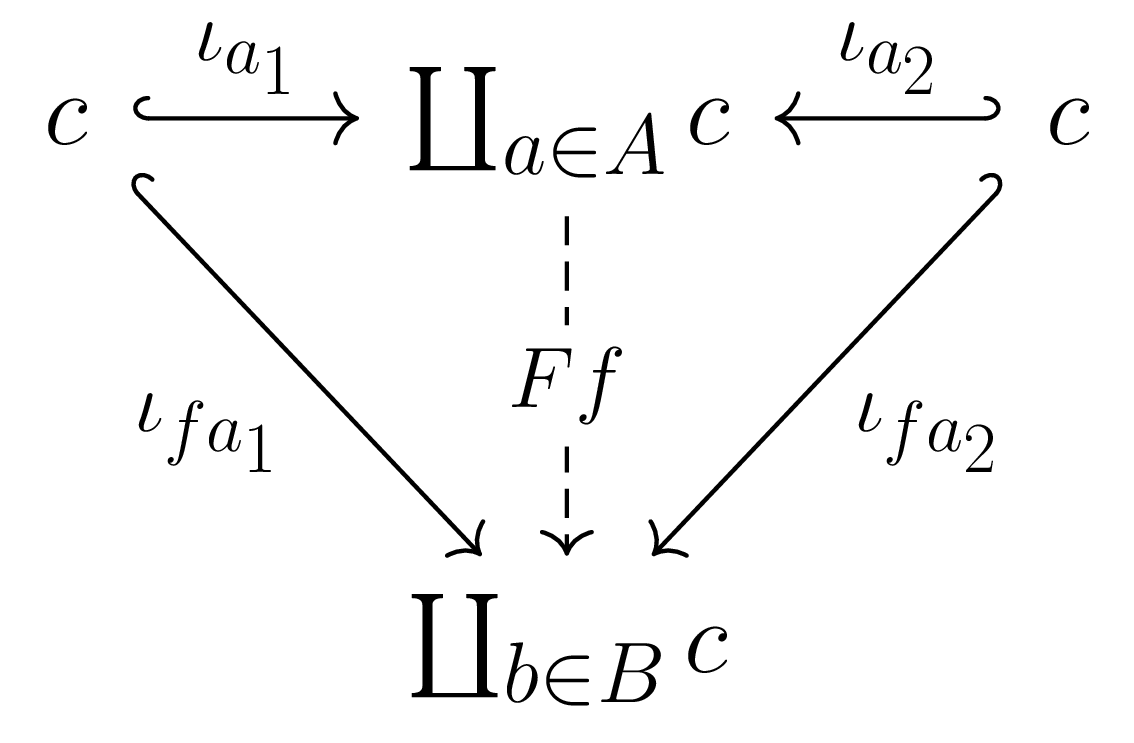
Indeed $L$ preserves identities, for $L 1_A$ uniquely factors the colimit cone under a particular diagram through that diagram's colimit, and hence $L 1_A$ must be the identity morphism on the colimit $FA$. Uniqueness of the universal property of colimits ensures that $Lg\circ Lf = L(g\circ f)$ for appropriate $f\colon A\to B, g\colon B\to D\in \text{Set}$ as well; $Lg\circ Lf$ and $L(g\circ f)$ both factor an $A$-indexed cone given by $\left\{\iota_{gfa}\right\}_{a\in A}$ through $LA$, but this factorization is unique.
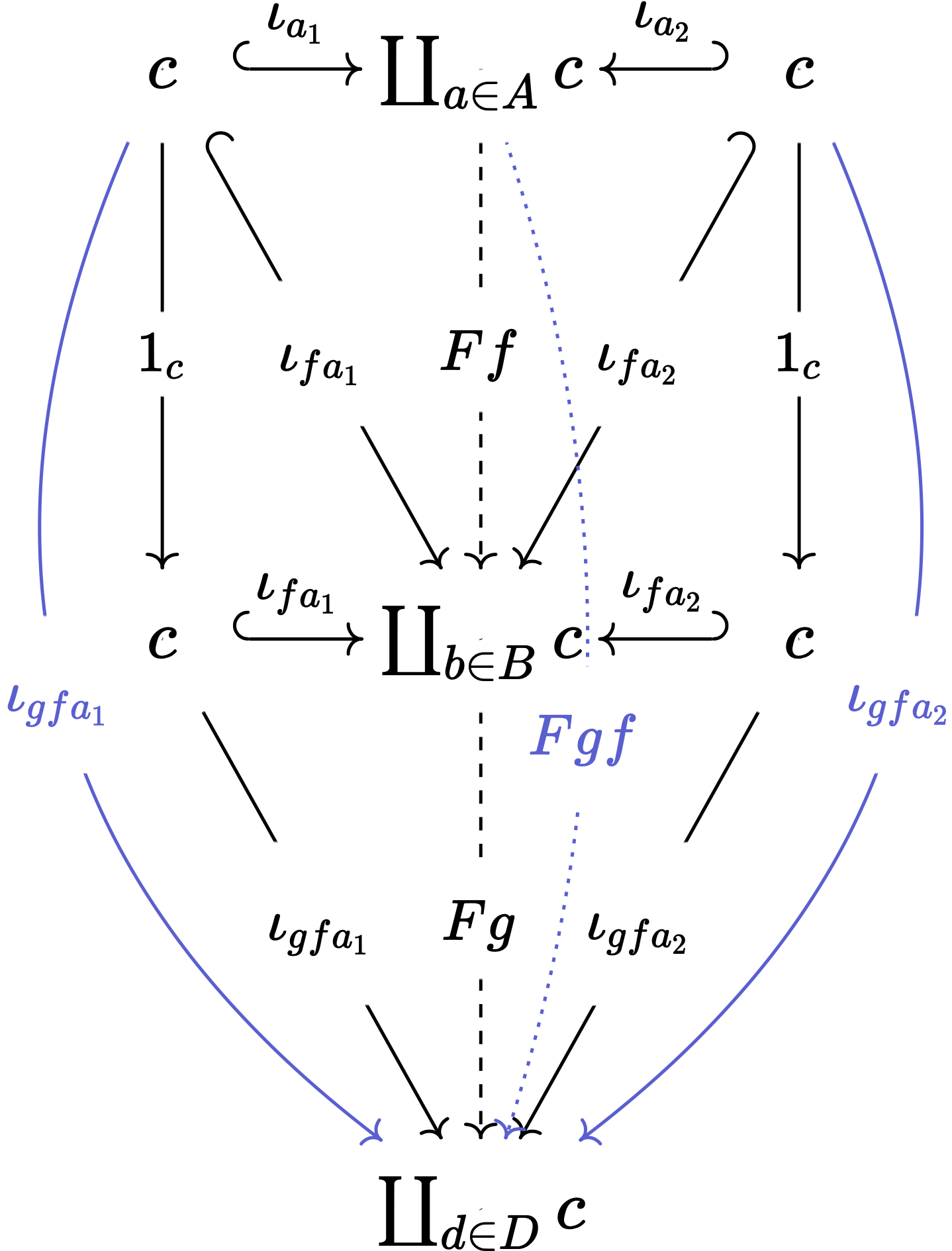
Thus, $L$ as defined is functorial. To show $L\dashv F$, we will construct the counit $\epsilon\colon LF\Rightarrow 1_{\text{C}}$ and demonstrate that it observes a certain universal property; namely, that it defines an isomorphism
$\epsilon_d$ is an arrow $LFd\to d$, which is equivalently an arrow $\coprod_{C(c,d)} c\to d$. This description invites a natural construction; we will take $\epsilon_d$ to be the unique arrow factoring the cocone under the diagram $C(c,d)\to c$ with nadir $d$, whose components are given by the associated indexing arrows $c\to d$ of the indexing category, through the coproduct $\coprod_{C(c,d)} c$. The universal property of this factorization yields the formula $\epsilon_d\circ\iota_{f_i\colon c\to d} = f_i$.
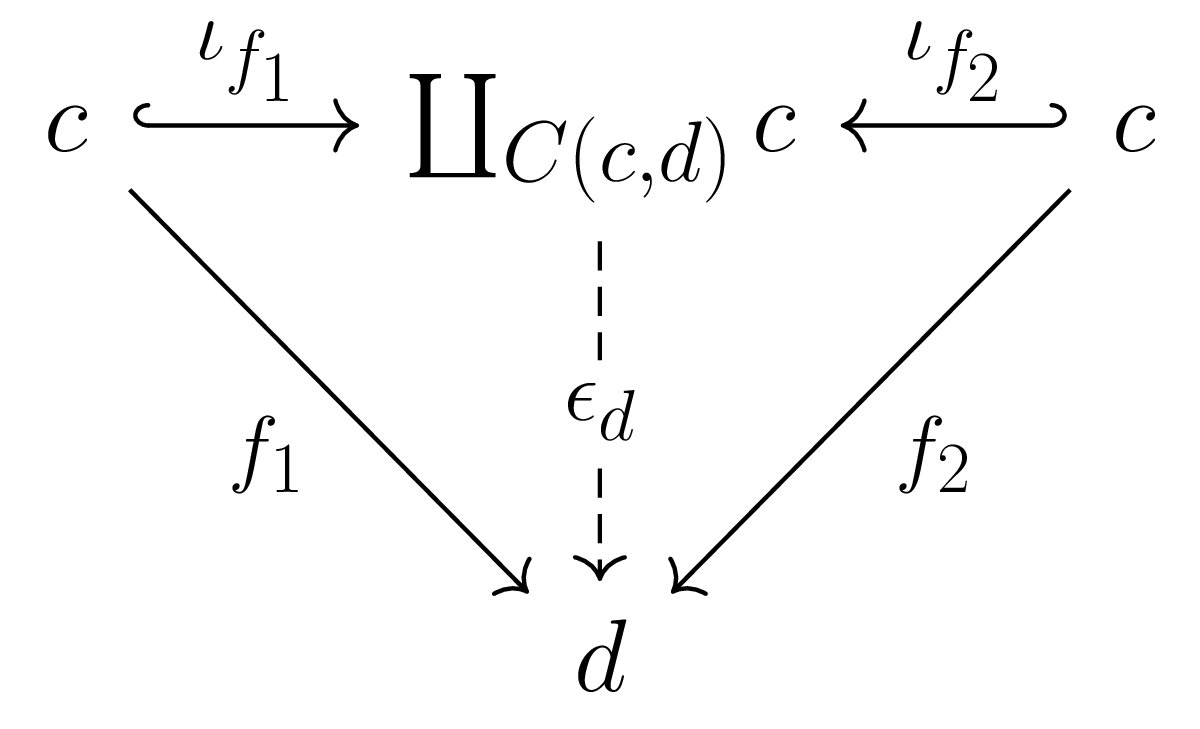
Naturality of $\epsilon$ follows from a straightforward diagram chase. Fixing a morphism $g\colon d\to e\in C$ and an inclusion $\iota_{f_i\colon c\to d}\colon c\hookrightarrow \coprod_{C(c,d)} c$, we have that $g\circ \epsilon_d\circ\iota_{f_i} = g\circ f_i$ and also $\epsilon_e \circ LFg\circ\iota_{f_i} = \epsilon_e\circ\iota_{g\circ f_i}=g\circ f_i$.
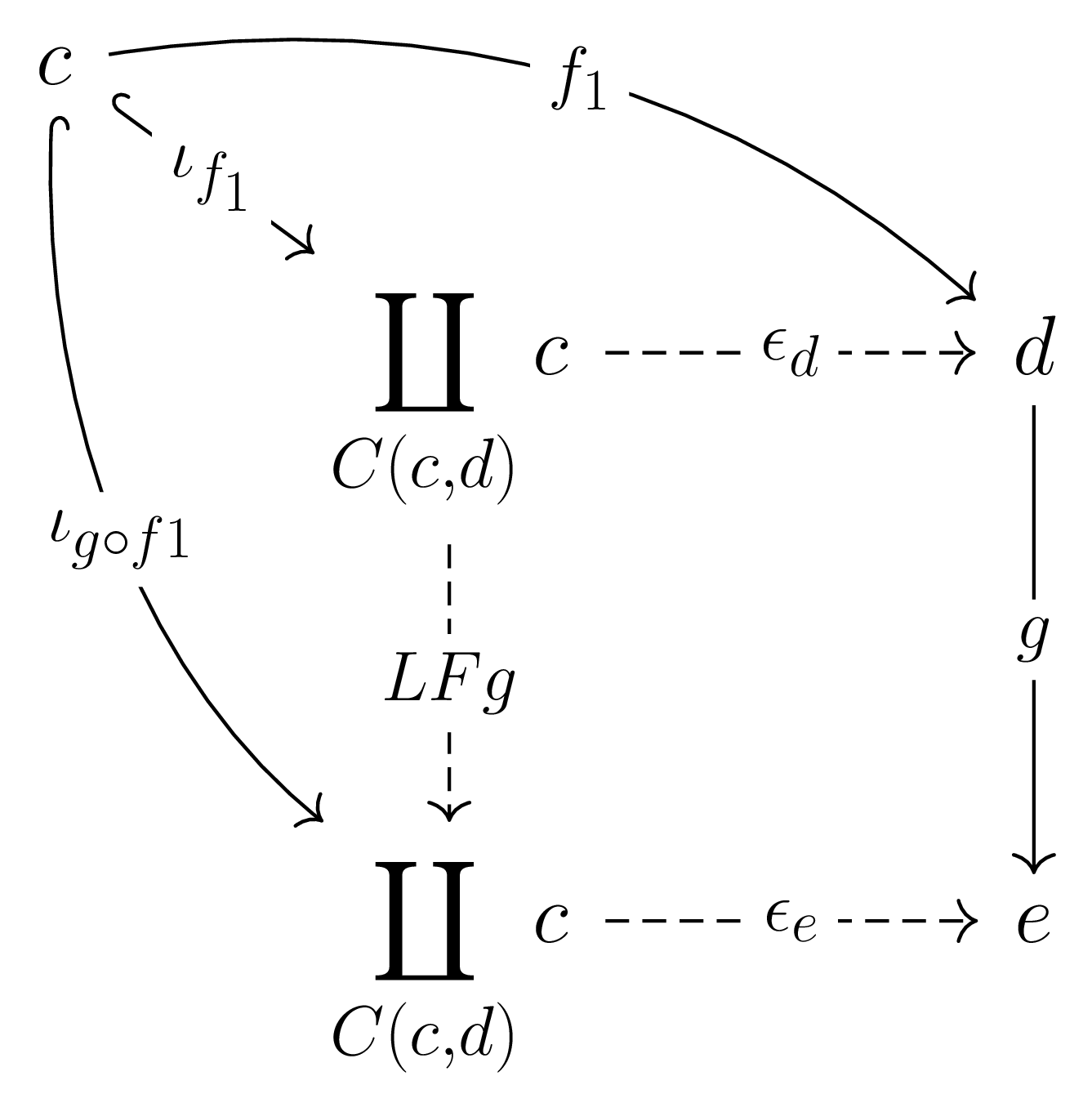
It remains to show the arrow $({\epsilon_d})_{*}\circ L\colon \text{Set}(A, Fd)\cong C(LA, d)$ is really a bijection. Representability of $F$ and the action of $L$ imply that $({\epsilon_d})_{*}\circ L$ is equivalently the composite
First, let us see injectivity. Taking distinct $f,g\colon A\rightrightarrows C(c,d)$, we have that $Lf$, $Lg$ are the unique factorizations of certain distinct cocones under $A$; by the representability of cocones under $A$ and the Yoneda lemma, $Lf$ and $Lg$ are distinct. In another way, $f, g$ being distinct implies $\exists a\in A$ such that $f(a)\ne g(a)$, and so $Lf\iota_a = \iota_{f(a)\colon c\to d} \ne \iota_{g(a)\colon c\to d} = Lg\iota_a$. But now
To see surjectivity, let us fix $f\colon \coprod_A c\to d$ and lift it along $({\epsilon_d})_{*}\circ L$ to an arrow $A\to C(c,d)$. $\coprod_A c$ is the representing object for $\text{Cone}(A, -)$, so $f$ corresponds to a unique cocone $\mu$ under $A$ with nadir $d$. But each $A$-indexed component of $\mu$ is an arrow $c\to d$, and so we can define a function $\bar{f}\colon A\to C(c,d)$ given by $\bar{f}(a)=\mu_a$. Indeed, $\bar{f}$ lifts along the present injection to be in the preimage of $f$; explicitly, $L\bar{f}$ is the unique factorization of a cone whose components are $\left\{\iota_{\bar{f}(a)} = \iota_{\mu_a}\colon c\to \coprod_{C(c,d)} c\right\}_{a\in A}$, and ${\epsilon_d}\circ L\bar{f}$ hence yields the cone $\left\{\epsilon_d\iota_{\mu_a} = \mu_a\right\}_{a\in A}=\mu$; uniqueness of cocone factorization implies ${\epsilon_d}\circ L\bar{f} = f$. $\square$
(4.5.vii) Characterizations of reflective subcategories
$\text{Premise}.$ Consider a reflective subcategory inclusion $D\hookrightarrow{}C$ with reflector $L\colon C\rightarrow D$.
Recall that a $D$ is a reflective subcategory of $C$ if $D$ is a full subcategory and the inclusion of $D$ admits a left adjoint $L$, which we call a reflector. This is definition 4.5.12 in Riehl.
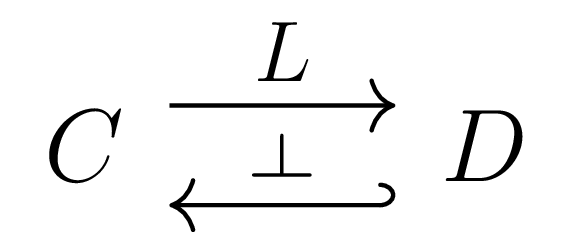
Let us denote the unit of this adjunction by $\eta\colon 1_{C}\Rightarrow L$ and the counit by $\epsilon\colon L\Rightarrow 1_D$; for now we elide the inclusion functor, for its presence in the domain definitions of the unit and counit acts as the identity.
Note also that because the inclusion $D\hookrightarrow C$ is fully faithful, $\epsilon$ is a natural isomorphism.
Okay, let's get started.
$\text{Part (i).}$ Show that $\eta L = L\eta$, and that these natural transformations are isomorphisms.
$\text{Proof.}$ By the triangle identities, $1_L = \epsilon L \circ L\eta$. Since $1_L$ and $\epsilon L$ are natural isomorphisms, we must have that $L\eta$ is a natural isomorphism.
Now consider the following triple of squares, each of which commutes either by the naturality of the unit or the counit.

Commutativity of the first square, which holds for all objects $c\in C$, tells us that $\epsilon L = L\epsilon$. Commutativity of the second and third squares imply $\epsilon L \circ L\eta = L \epsilon \circ \eta L = \epsilon L \circ \eta L$, and so $L\eta = \eta L$. Furthermore, $\eta L$ is a natural transformation because $L\eta$ is. $\square$
$\text{Part (ii).}$ Show that an object $c\in C$ is in the essential image of the inclusion $D\hookrightarrow C$, meaning that it is isomorphic to an object in the subcategory $D$, if and only if $\eta_c$ is an isomorphism.
$\text{Proof.}$ First, suppose $C\ni c\cong d\in D$, and that this isomorphism is given by $\phi\colon c\to d$. For clarity, we will denote the inclusion functor $\iota\colon D\hookrightarrow C$. By the triangle identities, we have that $1_\iota = \iota\epsilon\circ\eta\iota$; this implies $\eta\iota$ is a natural isomorphism. Now consider the square

which commutes by the naturality of $\eta$. $\eta_{\iota d}$, $\phi$, and $L\phi$ are isomorphisms, so $\eta_c$ is an isomorphism.
Conversely, supposing $\eta_c\colon c\to Lc$ is an isomorphism, $\eta_c$ defines an isomorphism between $c$ and $Lc\in D$. $\square$
$\text{Part (iii).}$ Show that the essential image of $D$ consists of those objects $c$ that are local for the class of morphisms that are inverted by $L$. That is, $c$ is in the essential image if and only if the pre-composition functions
are isomorphisms for all arrows $f\colon a\to b$ in $C$ for which $Lf$ is an isomorphism in $D$.
$\text{Proof.}$ Suppose that the class of pre-composition functions as described above, consisting of those functions whose image under $L$ are isomorphisms, are isomorphisms in $C$. Taking $c\in C$, we have that $L\eta_c$ is an isomorphism by $\text{(i)}$, and hence in particular $C(Lc,c)\xrightarrow{\eta_c}C(c,c)$ yields an isomorphism. This implies $\exists ! f\colon Lc\to c$ such that $f\eta_c = 1_c$. By the naturality of $\eta$, the square
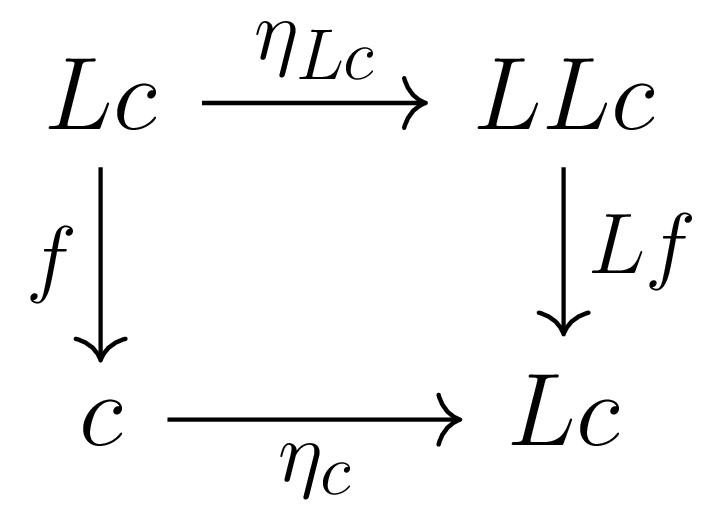
commutes, yielding the equivalence
Hence $\eta_c$ and $f$ are inverse isomorphisms. But $\eta_c$ being an isomorphism implies $c$ is in the essential image of $D$.
Conversely, supposing $c\in C$ is in the essential image of $D$, we have that $\exists d\in D$ with isomorphisms $\phi\colon c\leftrightarrows d\colon \phi^{-1}$. Let $f\colon a\to b\in C$ be such that $Lf$ is an isomorphism. Then by the definition of adjunction, the square
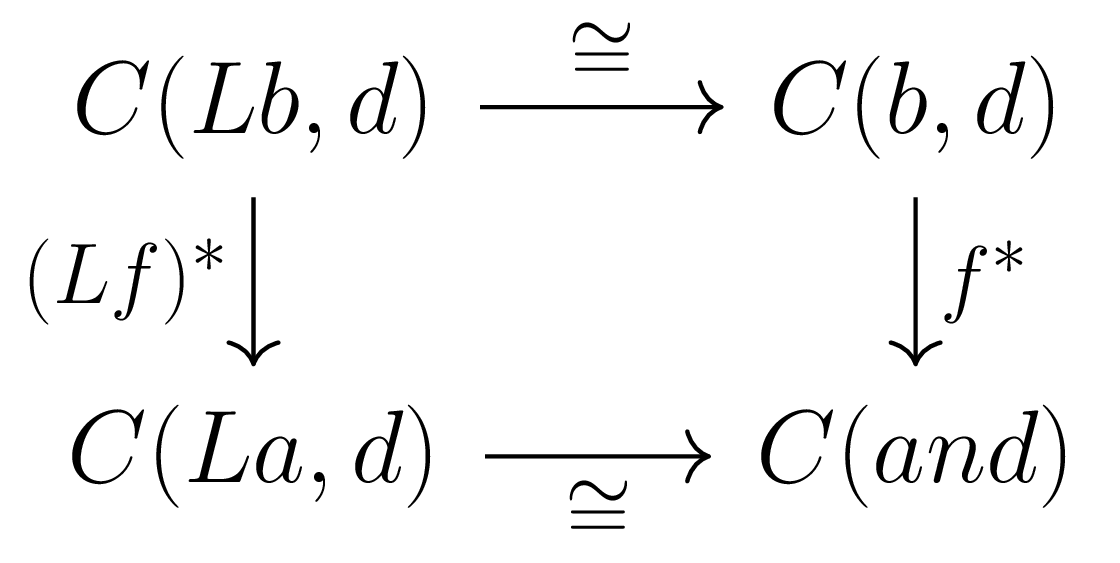
commutes. Since $Lf$ is an isomorphism, $(Lf)^*$ is an isomorphism, and so $f^*$ must be an isomorphism as well. Hence
is an isomorphism of hom-sets, satisfying the proposition hypothesis. $\square$
As Riehl points out, this last construction indeed describes why the reflector $L$ can be described as a localization. Indeed, the left adjoint $L$ determines the essential image of a reflective subcategory via a particular universal property that inverts local morphisms.